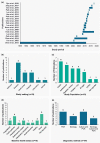A systematic review of the burden of pertussis in South Korea
- PMID: 33412085
- PMCID: PMC8115764
- DOI: 10.1080/21645515.2020.1844505
A systematic review of the burden of pertussis in South Korea
Abstract
This review summarizes the published data on epidemiology and burden of pertussis in South Korea as these may be under-categorized. A systematic literature review of PubMed, SCOPUS, EMBASE and KMBASE was performed to identify published literature in South Korea since 2000. Pertussis detection rates among 19 eligible studies range from 0.7% to 100% across different age groups, detection methods and study settings. Highest rates are observed in infants, while adolescents and adults with pertussis infection may suffer from persistent coughing. Vaccination uptake of pertussis booster dose among adolescents and adults remains low while seropositivity (detection of anti-pertussis immunoglobulin G), is high among adults. This review reveals a high burden of vaccine-preventable pertussis in South Korea. Besides primary childhood vaccination, strategies like maternal immunization and decennial revaccination of adults should be considered. Active testing, reporting and better utilization of vaccine registries may provide insights for decision-makers nationwide.
Keywords: Korea; Pertussis; epidemiology; immunization; review; seropositivity; seroprevalence; vaccine.
Figures
Similar articles
-
Community awareness and predictors of uptake of pertussis booster vaccine in South Australian adults.Vaccine. 2015 Dec 16;33(51):7337-7343. doi: 10.1016/j.vaccine.2015.10.068. Epub 2015 Oct 26. Vaccine. 2015. PMID: 26514422
-
Acellular pertussis vaccine use in risk groups (adolescents, pregnant women, newborns and health care workers): a review of evidences and recommendations.Vaccine. 2012 Jul 27;30(35):5179-90. doi: 10.1016/j.vaccine.2012.06.005. Epub 2012 Jun 15. Vaccine. 2012. PMID: 22709953 Review.
-
Seroprevalence of pertussis antibodies in 6-17-year-old students in Ahvaz, south-west Islamic Republic of Iran.East Mediterr Health J. 2014 Oct 20;20(10):623-6. East Mediterr Health J. 2014. PMID: 25356693
-
A systematic review of the burden of pertussis disease in infants and the effectiveness of maternal immunization against pertussis.Expert Rev Vaccines. 2020 Jul;19(7):621-638. doi: 10.1080/14760584.2020.1791092. Epub 2020 Aug 9. Expert Rev Vaccines. 2020. PMID: 32772755
-
[Seroprevalence of pertussis toxin antibody in Manisa province of Turkey, after six years implementation of acellular pertussis vaccine].Mikrobiyol Bul. 2018 Apr;52(2):180-189. doi: 10.5578/mb.57534. Mikrobiyol Bul. 2018. PMID: 29933735 Turkish.
Cited by
-
Risk Factors of Pertussis Among Older Adults in South Korea: A Nationwide Health Data-Based Case-Control Study.Infect Dis Ther. 2023 Feb;12(2):545-561. doi: 10.1007/s40121-022-00747-0. Epub 2023 Jan 2. Infect Dis Ther. 2023. PMID: 36588139 Free PMC article.
-
Post-Marketing Surveillance of Tetravalent Diphtheria-Tetanus-Acellular Pertussis and Inactivated Poliovirus (DTaP-IPV) Vaccine in South Korea, 2009 to 2015.Infect Dis Ther. 2022 Aug;11(4):1479-1492. doi: 10.1007/s40121-022-00650-8. Epub 2022 May 14. Infect Dis Ther. 2022. PMID: 35575974 Free PMC article.
-
Bacterial Etiology in Subacute Cough.Allergy Asthma Immunol Res. 2023 Sep;15(5):673-681. doi: 10.4168/aair.2023.15.5.673. Epub 2023 Apr 26. Allergy Asthma Immunol Res. 2023. PMID: 37153983 Free PMC article.
-
Collateral Impact of COVID-19 Prevention Measures on Re-Emergence of Scarlet Fever and Pertussis in Mainland China and Hong Kong China.Int J Environ Res Public Health. 2022 Aug 11;19(16):9909. doi: 10.3390/ijerph19169909. Int J Environ Res Public Health. 2022. PMID: 36011545 Free PMC article.
-
Immunogenicity and Safety of a Newly Developed Tetanus-Diphtheria Toxoid (Td) in Healthy Korean Adolescents: a Multi-center, Randomized, Double-blind, Active-Controlled Phase 3 Trial.J Korean Med Sci. 2021 Dec 20;36(49):e313. doi: 10.3346/jkms.2021.36.e313. J Korean Med Sci. 2021. PMID: 34931494 Free PMC article. Clinical Trial.
References
-
- CDC . Epidemiology and prevention of vaccine-preventable diseases. Washington D.C., US, Public Health Foundation: National Center for Immunization and Respiratory Diseases, Centers for Disease Control and Prevention; 2015.
-
- European Centre for Disease Prevention and Control . Expert consultation on pertussis. Accessed 2020 June10.https://www.ecdc.europa.eu/en/publications-data/expert-consultation-pert...
-
- WHO . Pertussis vaccines: WHO position paper – august 2015. Wkly Epidemiol Rec. 2015:35.
Publication types
MeSH terms
Substances
LinkOut - more resources
Full Text Sources
Other Literature Sources
Medical



